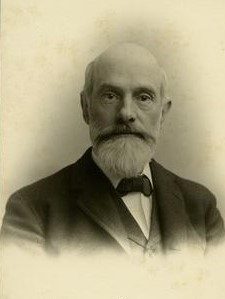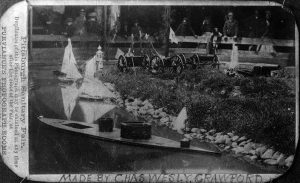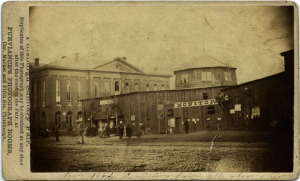A Most Profitable Ironclad: The Miniature Monitor That Raised Funds and Hope for the Union
To be certain, the medical arm of the United States military was unprepared for the scope of the war that was thrust upon it in 1861, counting only 98 physicians in its ranks at the outbreak of the Civil War. Following the bloodletting at First Bull Run, several relief organizations were assembled to assist with the obvious shortfall in providing for the needs of the sick and wounded Federal soldiers. Chief among these organizations was the United States Sanitary Commission (U.S.S.C.), which established and staffed hospitals and rest homes, and provided soldiers with food, medical supplies, and transportation. Funded chiefly by state tax funds, the U.S.S.C. relied heavily on donations and local support. Additional organizations, such as the United States Christian Commission and local aid societies likewise supported soldiers with medical aid and necessities.
As a means of generating both donations for the U.S.S.C. and enthusiasm for the war effort, cities in 1863 began organizing sanitary fairs. Often involving music, performances, and exhibition halls filled with lavish historical, mechanical, and patriotic displays, cities vied to ‘out raise’ donation totals realized at other fairs throughout the northern states. At least thirty U.S.S.C.-sanctioned sanitary fairs were held in various cities between the winter of 1863 and the summer of 1865. One attraction at the 1864 Pittsburgh Sanitary Fair would go on to generate interest, enthusiasm, and some serious money at fairs across the country.

In the spring of 1864, Charles W. Crawford, an employee of the Fort Pitt Foundry in Pittsburgh, decided to craft a model of the famed ironclad Monitor, envisioning that his miniature might float in one of the fountains in downtown Pittsburgh during the city’s Sanitary Fair. On hearing of Crawford’s plan, William Metcalf, superintendent of the Fort Pitt Works, encouraged his employee to dream bigger than a simple fountain model, offering to cover the cost of all labor and materials, and provided Crawford with a three-man team to bring his dream to life. Metcalf saw the potential in the miniature ironclad as a centerpiece of the Sanitary Fair so much that he supervised the construction of a new building, approximately 175x75ft, to showcase not only Crawford’s Monitor, but the heavy artillery and armaments then being produced at the Fort Pitt Foundry for the Union war effort. Dubbed “Monitor Hall,” the building was itself equipped with a replica turret, under which was enclosed a large, elliptical-shaped reservoir on which the Monitor would float.

Short on plans for the original Monitor, which sank off Cape Hatteras on December 31, 1862, Crawford and his team did not have to look far for inspiration. The USS Manayunk, a Canonicus-class monitor, was then under construction in Pittsburgh, and like Monitor, sported a single turret, small pilot house, and the distinctive iron plate armor. While not an exact model, it would be close enough for the general public.
Crawford’s team got to work, laying the hull with a ten-foot sheet of copper over two perpendiculars and twenty-inch beams. The deck plates were made of wrought iron, and the turret and guns cast iron, supplied by the Fort Pitt Foundry. One team member developed an oscillating, 1.5-inch stroke engine, while the boiler was fashioned from a two-foot section of copper. The steam necessary to propel the boat was generated by a series of alcohol lamps along the bottom of the boiler, with gutta percha tubes carrying the steam to the engine. A brass propeller at 2/1 speed would propel the nearly ten-foot craft through the water.
One completed, the Monitor floated on an even keel, with approximately 2 inches of deck rising above the waterline. However, during a pre-Fair test run on the Allegheny River, the miniature ironclad swung under a skiff and sank in twenty feet of water. A diver was hired to retrieve the boat, though its two, two-foot guns were lost in the incident and had to be recast.

Inside Monitor Hall, the reservoir was constructed around a large, sodded island, on which was erected a miniature fort sporting redoubts, rifle pits, and at least five miniature cannons. The reservoir was stocked with fish, and a lighthouse constructed on one side, where nearby a miniature of the Merrimac floated. A flotilla of smaller sailboats bobbed in the water. While the Merrimac remained moored and silent, the Monitor would circumnavigate the reservoir, firing small charges at its foe while being met by rounds from the island guns, offering spectators a glimpse of naval warfare “on a small scale.”

Elsewhere in Monitor Hall visitors could see a breech loading cannon, patented by Henry F. Mann in 1861, a model of the monster 20-inch Rodman gun cast at the Fort Pitt Foundry, and numerous mortars, field pieces, and various ordinance, such that one Pittsburgh newspaper believed that the impressions of a visit to Monitor Hall “will never fade from…memory.”
From June 1 – 18, 1864, the Monitor was viewed by thousands of visitors. At 25 cents admission, it was estimated that Monitor Hall alone generated $75,000 of the more than $300,000 raised at the Pittsburgh Sanitary Fair. Other cities took notice and called on the Fort Pitt Foundry to exhibit the Monitor at their fairs. It was decided that one of Crawford’s team would travel with and conduct the exhibition as a goodwill venture.
The Monitor first traveled to the Wheeling, West Virginia Sanitary Fair in July 1864, where a similar Monitor Hall was built around a moat dug by Union and Confederate prisoners from the Athenaeum Prison. The Monitor again proved a crowd favorite, and with the statue of George Washington recently looted from the Virginia Military Institute, drew thousands of visitors and dollars to the U.S.S.C. coffers.

Over the next year the Monitor continued making the rounds at fairs in Baltimore, Boston, Philadelphia, and Chicago. At the Boston Sailors Fair, the frog pond on Boston Common was enclosed and a viewing platform erected, the Boston Transcript gushing that the Monitor was “ingeniously constructed,” and that “with the noise of the machinery, and the puffs of the steam, it is, of itself, a most novel and interesting sight.”
The Monitor was displayed for nearly a month at the Great North-Western Sanitary Fair in Chicago. In the final days of the fair, the premature discharge of one of the island cannons shattered the foot of the team member traveling with the exhibition, seemingly the only bloodshed of the protracted land/naval battle.
At the conclusion of the Chicago fair in June 1865, and with hostilities recently ended, the miniature was raffled, garnering a final $500.00 for the U.S.S.C. The model resurfaced two decades later, when in 1887 the Monitor was donated for display at the Grand Army Hall and Memorial Association in Chicago. Its subsequent whereabout are unknown.
Charles W. Crawford remained proud of his invention and theorized that his miniature Monitor likely made more round trips and raised more money than any miniature or model boat prior, and was perhaps the smallest successful example of a steam-powered boat. The Monitor did indeed captivate audiences and raised badly needed funds for the U.S. Sanitary Commission. Even with its diminutive size, Crawford believed the Monitor was “entitled to a conspicuous place in the history of our defunct navy.”
As always, Jon-Erik has produce another great work. Excellent article.
I’d only seen that image of the model ship before, and this is a really great summary. Nicely done.
So interesting! They really had some great and unique ideas for drawing a crowd at those Sanitary Fairs. Thanks for sharing this research.